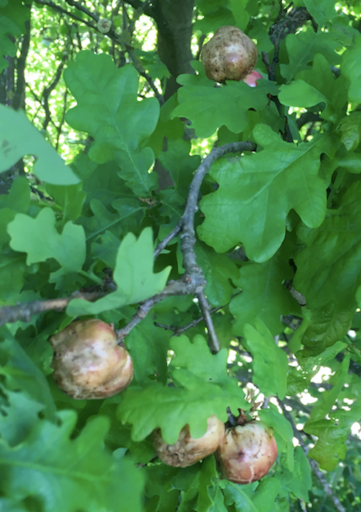
Everyone knows that apples grow on apple trees, and acorns grown on oak trees. What of oak apples? They're quite a curious growth like a slightly deformed apple on some oak trees. There are lots of clusters them on one of the friendly oak trees (I always think of oak trees as the most sociable trees, with ash coming a close second) near me at the moment.
Despite their appearance, they're not fruit at all but are a kind of nest created by wasps. The female lays eggs in a new leaf, causing the gall to grow with larvae inside. In around June the wasps hatch, drop to the ground and then inject the tree roots with eggs. Eventually the wingless females climb up the tree to repeat the process. No oak trees are harmed in this process.
So why does this curious sphere have its own day? 29th May is Oak Apple Day, commemorating Charles II's escape from capture by the Parliamentary forces by hiding in the Boscobel Oak in Shropshire. An act of parliament meant this became a public holiday and is still celebrated by some. Chelsea Pensioners attach oak leaves to their scarlet uniforms on Founder's Day (celebrated as close as possible to Oak Apple Day) at the Royal Hospital Chelsea, which was founded by Charles II.
Oak apples have played another important role in history. The galls have a high tannin content and they have been used to make ink since Roman times. Documents such as the Magna Carta and American Declaration of Independence were written with oak gall ink.
I mentioned a sort-of-magic trick. If you pick an oak apple at the right time as it's becoming drier and more papery, then put your head back, blow a continuous stream of air and let go of the oak apple, you should be able to keep it in suspended animation in the air by blowing... or so I'm told.

 RSS Feed
RSS Feed
